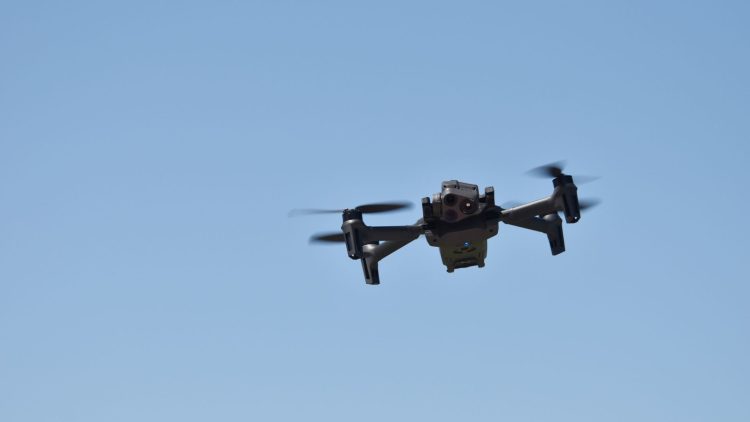Last month, at the Brookings Institution, a century-old American think tank, Vice Chief of Staff General James C. Slife discussed how the US Air Force is reassessing its approach to air superiority in response to the growing threat of small, low-cost drones.
In recent years, these high-tech gadgets have become advantageous and pesky devices that significantly impact modern warfare.
Here’s a recap of Slife’s talk on the matter.
Why Drones are the New Headache in Warfare
Unless you’ve been living with blinders on, you’ve likely heard that recent hot zones, particularly in Ukraine and the Middle East, have highlighted the rapid proliferation of drones.
These unmanned aerial vehicles (UAVs), whether they’re carrying primary explosives or equipped with high-tech surveillance gear, have shown themselves to be tough opponents, as we’ve covered in many of our past articles.
Drones’ ability to operate in swarms, at low altitudes, and with minimal radar signature has also rendered traditional air defense systems less effective.
“We used to make the claim that since 1953, no American has been killed by air attack,” Slife said at the Brookings Institution’s event last July 29, cited by Air&Space Force Magazine.
Slife stressed that the idea of air superiority needs to shift from the high-altitude dominance of the Cold War to include today’s more complex, multi-domain battlespace. The Cold War is long over and we need to look toward the future with fresh eyes.
“We can’t make that claim anymore.”
Advertisement
Rethinking the Skies: Air Superiority vs. Drones
Let’s face it: It costs the Air Force a boatload of money to keep scrambling F-22s or F-15s after every rogue drone—let alone swatting swarms of drones!
That service and the armed forces as a whole must find ways to counter these threats without breaking the bank; that’s basically what Slife said and probably something you and I can agree on. Even warfare has it’s own economic realities.
Recently, the Middle East has become a hotbed of drone action, with Iran-backed factions turning cheap tech into deadly assaults on both troops and towns.
While high-end platforms like the F-22 and costly missiles have been effective in some instances, such as protecting Israel from an Iranian barrage, the sheer number of these budget-friendly buggers is stretching our defenses (and budget) thin.
These drone strikes are exposing cracks in our armor, pushing the brass to think outside the box on air dominance—one that can effectively counter the asymmetric threat posed by drones.
During his speech at the event, Slife further gave us a glimpse into a possible future, one where we roll smaller drones into our lineup.
He drew parallels back to the early days of aviation in the Spanish Civil War, hinting that we might be on the brink of a new chapter in combat, molded by the lessons of today’s drone wars.
Just as the world saw the transformative power of aircraft before World War II, the General believes drones are now set to redefine military strategy.
“I hope there’s not a World War III, but if there is, I wonder to what extent the lessons are starting to take shape in places like Israel today, Ukraine, and so forth,” Slife noted. “So we’re keenly interested in what we can what we can pick up from that.”
You can catch the full scope of his thoughts below.
As a result, the Air Force is looking into fresh strategies, like using small drones as defense tools and adding artificial intelligence (AI) to boost awareness and quick responses. The word “nimble” comes to mind.
What’s Next for Airpower? Drones and More!
The Air Force is pouring resources into autonomous systems, aiming to develop Collaborative Combat Aircraft (CCA), as we previously covered, that can fly alongside manned fighters.
CCA represents the next evolution in warfare, the new wave, blending human-piloted aircraft with advanced, autonomous drones to enhance combat capabilities. These unmanned systems, designed to work in tandem with manned fighter jets, provide a force multiplier on the battlefield. Their sophisticated artificial intelligence (AI) enables them to perform multiple tasks, such as gathering intelligence, executing electronic warfare, or even engaging enemy targets autonomously. By working together with human oversight in a coordinated and dynamic way, CCAs can handle the most dangerous missions, allowing flesh and blood pilots to stay out of harm’s way as much as possible while expanding the reach and effectiveness of air operations.
The introduction of CCAs also marks a significant shift in modern military strategy. These aircraft are versatile and can be produced and deployed at a fraction of the cost of traditional fighter jets. This makes them an appealing option for nations looking to maintain air superiority without breaking the budget. With advancements in artificial intelligence and machine learning, CCAs will continue to evolve, becoming smarter and more capable of adapting to rapidly changing combat environments. They won’t replace piloted jets but act as a cohesive force alongside them. In time, they will redefine how airpower is projected in future conflicts, offering strategic flexibility and technological dominance to future warfighters.
For now, one thing’s for sure: we’re only at the start of the drone era, and the US Air Force is ready to shake up how we think about warfare.
—
Disclaimer: SOFREP utilizes AI for image generation and article research. Occasionally, it’s like handing a chimpanzee the keys to your liquor cabinet. It’s not always perfect and if a mistake is made, we own up to it full stop. In a world where information comes at us in tidal waves, it is an important tool that helps us sift through the brass for live rounds.










COMMENTS
You must become a subscriber or login to view or post comments on this article.